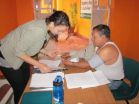Scientists find aphid resistance in black raspberry
2012-10-31
(Press-News.org) There's good news for fans of black raspberries: A U.S. Department of Agriculture (USDA) scientist and his commercial colleague have found black raspberries that have resistance to a disease-spreading aphid.
Agricultural Research Service (ARS) horticulturist Chad Finn with the agency's Horticultural Crops Research Unit in Corvallis, Ore., and colleague Michael Dossett of Agriculture and Agri-Food Canada are the first to find and report black raspberry resistance to the large raspberry aphid.
ARS is USDA's chief intramural scientific research agency, and this research supports the USDA priority of promoting international food security.
The researchers screened seedlings from 132 wild black raspberry populations for aphid resistance. According to Finn, strong resistance was found in three of these populations—one each from Ontario, Maine, and Michigan. Aphid resistance in the Ontario and Maine populations seems to be controlled by multiple genes, while resistance in the Michigan population is governed by one dominant gene.
Identifying these genes makes it easier for breeders to incorporate aphid resistance into commercial black raspberry cultivars.
Aphid control is important because fruit production is severely impacted by black raspberry necrosis virus, which is transmitted by the large raspberry aphid. This and other aphids are important virus vectors in North American black raspberries.
Although breeding for aphid resistance has been recognized as an important tool for protecting red raspberries from viral infection, this is the first report of aphid resistance in black raspberry, according to Finn.
INFORMATION:
Read more about this and other fruit and vegetable research in the October 2012 issue of Agricultural Research magazine.
http://www.ars.usda.gov/is/AR/archive/oct12/fruits1012.htm
USDA is an equal opportunity provider and employer. To file a complaint of discrimination, write: USDA, Office of the Assistant Secretary for Civil Rights, Office of Adjudication, 1400 Independence Ave., SW, Washington, DC 20250-9410 or call (866) 632-9992 (Toll-free Customer Service), (800) 877-8339 (Local or Federal relay), (866) 377-8642 (Relay voice users).
END
ELSE PRESS RELEASES FROM THIS DATE:
2012-10-31
Women who drink green tea may lower their risk of developing some digestive system cancers, especially cancers of the stomach/esophagus and colorectum, according to a study led by researchers from Vanderbilt-Ingram Cancer Center.
The study by lead author Sarah Nechuta, Ph.D., MPH, assistant professor of Medicine, was published online in advance of the Nov. 1 edition of the American Journal of Clinical Nutrition. Wei Zheng, M.D., Ph.D., MPH, professor of Medicine, chief of the Division of Epidemiology and director of the Vanderbilt Epidemiology Center, was the principal ...
2012-10-31
PROVIDENCE, R.I. [Brown University] — A Medicare rule that blocks thousands of nursing home residents from receiving simultaneous reimbursement for hospice and skilled nursing facility (SNF) care at the end of life may result in those residents receiving more aggressive treatment and hospitalization, according a new analysis.
"This study is the first, to the knowledge of the authors, to attempt to understand how treatments and outcomes vary for nursing home residents with advanced dementia who use Medicare SNF care near the end of life and who do or do not enroll in Medicare ...
2012-10-31
As men and women age, increasing quantities of fat tissue inevitably take up residence in skeletal muscle. A small study of older and younger men conducted at the Jean Mayer USDA Human Nutrition Research Center on Aging at Tufts University suggests that a build-up of a fat molecule known as ceramide might play a leading role in muscle deterioration in older adults. The results of the study were published online this month by the Journal of Applied Physiology, a publication of the American Physiological Society.
The study enrolled ten 10 men in their mid-seventies to ...
2012-10-31
VIDEO:
For the last decade, prematurity has been the leading cause of infant mortality in the US. As a result of prematurity, many infants enter this world too early with a...
Click here for more information.
For the last decade, prematurity has been the leading cause of infant mortality in the United States. As a result of prematurity many infants enter this world too early with a small chance of survival. In order to help treat these extremely premature infants, physicians ...
2012-10-31
A consortium of Quebec researchers coordinated by the Medical Genetics Service of the Sainte-Justine UHC has just published the findings of a 25-year study on the treatment of tyrosinemia, a life-threatening liver disease of genetic origin, which is screened at birth in the province of Quebec, where it is much more frequent than anywhere else in the world. "After five years of treatment, no trace of the disease can be detected in the liver of newborns who were treated with nitisinone starting from the first month of life," states Dr. Grant Mitchell of the Sainte-Justine ...
2012-10-31
Flame retardants in the polyurethane foam of millions of upholstered sofas, overstuffed chairs and other products have ignited a heated debate over safety, efficacy and fire-safety standards -- and a search for alternative materials. That's the topic of a cover story package in the current edition of Chemical & Engineering News (C&EN), the weekly newsmagazine of ACS, the world's largest scientific society.
An overview of the package describes the controversy, fostered largely by a California chemist, who claims that flame retardants pose unacceptable toxic hazards and ...
2012-10-31
The yeast used to make beer has yielded what may be the first gene for beer foam, scientists are reporting in a new study. Published in ACS' Journal of Agricultural and Food Chemistry, the discovery opens the door to new possibilities for improving the frothy "head" so critical to the aroma and eye appeal of the world's favorite alcoholic beverage, they say.
Tomás G. Villa and colleagues explain that proteins from the barley and yeast used to make beer contribute to the quality of its foam. The foamy head consists of bubbles containing carbon dioxide gas, which yeast ...
2012-10-31
In an advance toward analyzing blood and urine instantly at a patient's bedside instead of waiting for results from a central laboratory, scientists are reporting development of a new micropump capable of producing pressures almost 500 times higher than the pressure in a car tire. Described in ACS' journal Analytical Chemistry, the pumps are for futuristic "labs-on-a-chip," which reduce entire laboratories to the size of a postage stamp.
Shaorong Liu and colleagues explain that powerful pumps are critical for high performance liquid chromatography (HPLC), a mainstay laboratory ...
2012-10-31
Using the legendary properties of heartwood from the black locust tree as their inspiration, scientists have discovered a way to improve the performance of softwoods widely used in construction. The method, reported in the journal ACS Applied Materials & Interfaces, involves addition of similar kinds of flavonoid compounds that boost the health of humans.
Ingo Burgert and colleagues explain that wood's position as a mainstay building material over the centuries results from a combination of desirable factors, including surprising strength for a material so light in weight. ...
2012-10-31
ANN ARBOR, Mich. — Hypertension is one of the greatest epidemics threatening the health of people in low and middle-income countries.
For patients struggling with high blood pressure in countries with limited access to health care, the key to improving health may be as simple as a phone call.
New University of Michigan research evaluated the impact of automated calls from a U.S.-based server to the mobile phones of patients with hypertension (high blood pressure) in Honduras and Mexico. The program was designed to be a low-cost way of providing long distance checkups ...
LAST 30 PRESS RELEASES:
[Press-News.org] Scientists find aphid resistance in black raspberry

